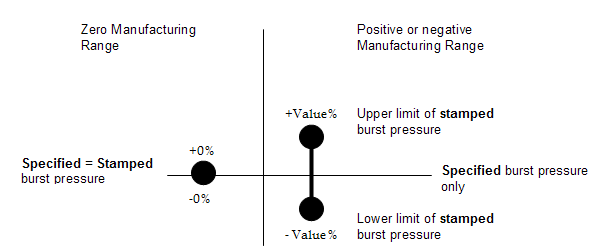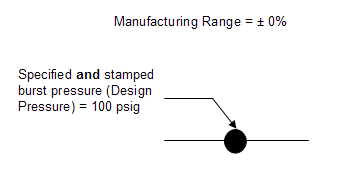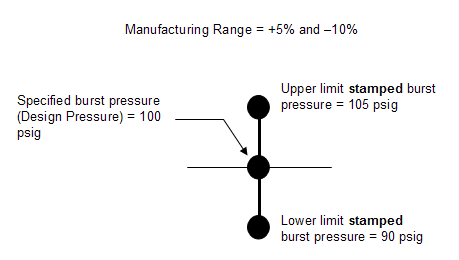Chemical and Process Engineering Resources

Rupture Disks for Process Engineers - Part 3
Nov 08 2010 01:30 PM | pleckner in Safety and Pressure ReliefStamped Burst Pressure
What should the expected stamped (rated) burst pressure of the rupture disk be?
What do we mean by "stamped or rated" burst pressure? Per code, the rupture disk vendor must provide a tag containing, amongst other things, the rated or what is typically called the stamped burst pressure. This is a guaranteed value so the user knows (within an allowable tolerance; more on this later) the exact bursting pressure of the rupture disk. Also this stamped burst pressure must never exceed the design pressure (or MAWP); except for the special case mentioned above.
So, the rupture disk vendor stamps the disk with the burst pressure specified by the process engineer? Not necessarily!
Manufacturing Range (MR)
 |
| Figure 1: Graphical Representation of the Manufacturing Range |
A rupture disk is made out of a sheet of material, e.g. stainless steel, high alloys, ceramics, etc. Like all things in this world, this sheet of material is not perfect. To quantify the inaccuracies in sheet material thickness, the vendor uses what is called the Manufacturing Range (MR).
 |
| Figure 2A: Specified and Stamped Burst Pressure |
Â
The MR is expressed as ±% of the specified burst pressure. It determines the highest pressure above the specified burst pressure or the lowest pressure below the specified burst pressure that the disk can be stamped at. This is shown graphically in Figure 1.
Figure 1 shows the two extremes, a MR of ± 0% and a MR of ± some value%. Note that other combinations may be used such as + 0% and - some value% or - 0% and + some value%.
Let's look at an example. If the specified burst pressure is 100 psig with a MR of ± 0%, the stamped or rated burst pressure will be 100 psig (see Figure 2A). However, if the MR is +5% and - 10%, the disk can be delivered with a stamped burst pressure of 105 psig, 90 psig or anywhere in between (see Figure 2B). That's right, if the MR is anything but ± 0%, the user won't know the stamped burst pressure until the rupture disk is ready for shipment!
 |
| Figure 2B: Differences in Specified and Stamped Burst Pressures |
Do you see anything wrong with this rupture disk as specified?
Remember, the stamped or rated burst pressure must never exceed the vessel's design pressure or MAWP (assumes a single device, no special cases). Since the specified burst pressure is the design pressure, this particular rupture disk is not acceptable because the delivered rupture disk may have a stamped burst pressure of 105 psig or 5 psig greater than design!
How can we avoid this problem? There are a number of ways.
The process engineer specifies the Manufacturing Range, not the manufacturer. You can ask for any range within the capability of fabrication including ± 0%. Considering the potential problems, why specify anything other than ± 0%? Cost. A MR of +5% and -10% can save as much as 40% off the cost of a similar rupture disk with a MR of ± 0%. Even if you demand +0% (which you should), you can still realize some cost savings if a stamped burst pressure lower than specified is acceptable (not always a good idea as will be discussed later). Note that code only affects the upper stamped limit, not the lower.
Another way to avoid the potential violation of code and still get a cheaper rupture disk is to specify a burst pressure that will be lower than the vessel design pressure. Thus, when the MR is added the stamped burst pressure will not exceed the design pressure. The maximum allowable specified burst pressure could be determined in the following manner:
Pspec_max = (DP) - (+MR/100) x (Pspec_max)
Where DP = Design pressure
So:
Pspec_max = (DP) / [1+(+MR)/100]
Since DP = 100 psig and the upper value of MR = +5%,
Pspec_max = 100 /[1+(+5/100)] = 100/(1+0.05) = 100/1.05 = 95.2 psig
This rupture disk would be specified with a burst pressure no higher than 95.2 psig while the stamped burst pressure may be as high as 100 psig.
Note that the standard Manufacturing Range for most manufacturers is ± 0% and this is reflected in the base price you will be quoted.

 FB
FB

0 Comments